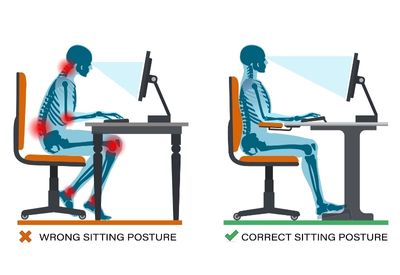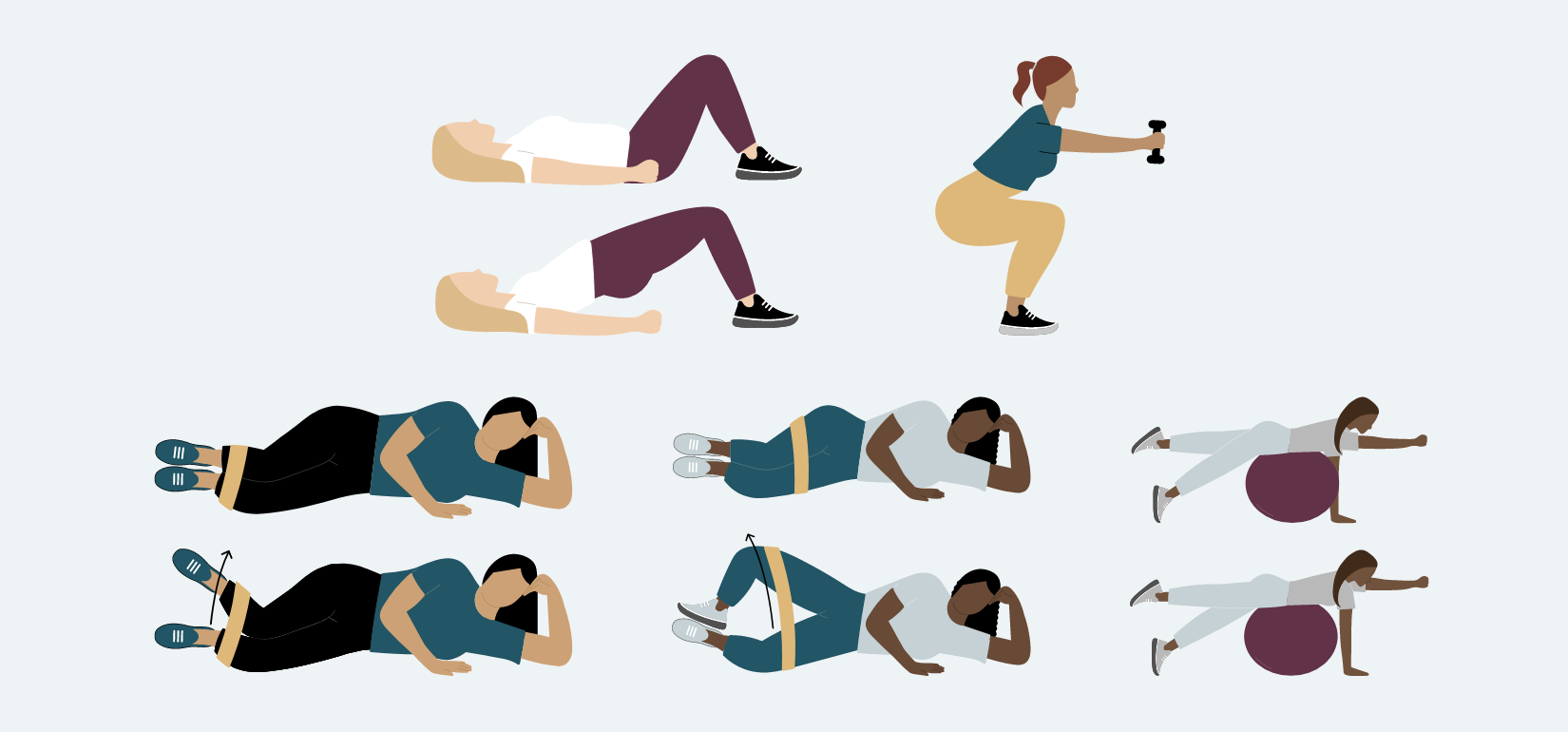Key Takeaways:
- Break up long periods of sitting with regular breaks and stretching to alleviate pressure on your pelvic floor muscles and reduce the risk of damage.
- Maintain good posture while seated to prevent pelvic floor dysfunction, focusing on shoulder alignment and avoiding excessive forward pelvic tilt.
- Engage in pelvic floor exercises like Kegels, consider standing options, and seek professional help if you're experiencing pelvic or back pain.


The average American sits for 6 to 8 hours a day—that's a long time! Suffice it to say that sitting is usually unavoidable, but it can have a significant impact on our health, so much so that experts are now saying sitting is the new smoking.
Sitting for prolonged periods can also harm your pelvic floor muscles, which keep your pelvic organs in place and help you maintain control of your bladder and bowels.
Find out how to keep your pelvic floor healthy while sitting for long hours.
Jump To:
Why Is Sitting Bad for Your Pelvic Floor?
The Connection Between Sitting & Your Pelvic Floor Health
8 Ways to Prevent Pelvic Floor Damage While Sitting
INCONTINENCE PRODUCTS THROUGH INSURANCE:
Aeroflow Urology is in-network with many Medicaid and Medicaid-managed insurance plans and is accredited by Medicaid. Complete our Eligibility Form, and we’ll automatically check to see if your plan covers incontinence supplies. ***Must meet certain requirements to qualify.***
You will also receive the care and attention every person managing incontinence deserves: A personalized list of 100% insurance-covered incontinence supplies, a dedicated Continence Care Specialist you can contact during business hours, a user-friendly online portal for easy monthly reordering, and educational content.
Get the continence care you need with the dignity you deserve. Join the Aeroflow Urology family today! It only takes 2 minutes to get started.
Check Your Eligibility
2 Easy Steps
Discover the adult incontinence products available through your insurance.
What Is Your Pelvic Floor?
The pelvic floor is crucial for women's health. It is a group of muscles that control different functions, such as urination, bowel movements, and sexual function.
To imagine your pelvic floor, think about a hammock that stretches from the front of your pubic bone, your urethra, vagina, and sides of your abductor muscles to your rectum and coccyx (tailbone). This hammock holds your pelvic organs safely in place.
Your pelvic floor is also responsible for your continence (ability to urinate and defecate). If you have pelvic floor dysfunction where your pelvic floor is damaged or weakened, you may experience incontinence (loss of control of bladder and bowel muscles).
Why Is Sitting Bad for Your Pelvic Floor?
It’s been reported that the average American adult sits for 6.5 hours every single day, or 2,373 hours per year!
While it may seem harmless and feel great, sitting for extended periods can harm your body, including your pelvic floor. Sitting can contribute to multiple health conditions developing, such as:
- Diabetes
- Pelvic floor damage.
- Incontinence (loss of bladder or bowel control, resulting in leakage).
- Decreased overall health.
- Weight gain or obesity.
- Pelvic pain.
- Back or spinal issues.
- Dementia
- Vascular problems.
- Heart disease.
- Depression
- Cancer


The Connection Between Sitting & Your Pelvic Floor Health
When you sit, you use your core, which consists of the diaphragm, trunk, obliques, and pelvic floor muscles. These muscles help stabilize you and support your pelvis and spine.
If you sit with poor posture or sit too long, your core and the parts of your body that make up that area, such as the pelvic muscles, can be impacted. Incorrect posture occurs when you hunch over or lean forward, tilting your pelvis forward and placing downward pressure on your pelvic muscles. This can lead to pelvic floor disorders, pelvic pain, fecal incontinence, and urinary incontinence.
Alongside sitting for a long time, living a sedentary lifestyle can increase your chances of developing incontinence as you age. The decreased movement causes your bladder tissues to overstretch from always sitting down, leading to damage.
Signs of Pelvic Floor Damage
Signs that you may be inflicting damage to your pelvic floor muscles include:
- Pelvic pain.
- Urinary incontinence.
- Hip pain.
- Difficulty making a bowel movement.
- Urinary frequency or urgency.
- Back or abdominal muscle spasms.
- Chronic pelvic or back pain, including lower back pain.
- Pain that runs down your legs from your lower back.


8 Ways to Prevent Pelvic Floor Damage While Sitting
There are lots of ways you can avoid sitting for too long and even help strengthen your pelvic floor if it's damaged.
1. Don't Sit for Too Long
Healthcare experts say you should sit for no more than 30 minutes at a time. It's recommended that you get up for 5 minutes for every 30 minutes that you're sitting. You should also never sit for more than 2 hours at a time.
2. Stretch During the Day
If you notice pain in your body or feel yourself falling into bad posture, stretch when you take a break from sitting.
Try to take a stretch break every 30-45 minutes while sitting. Set a timer to help you remember to stand up (there are several apps as well) or remember to get up every hour.
3. Watch Your Posture
Posture is the main reason for pelvic floor muscle damage. Improve your posture by rolling your shoulders back and squeezing your shoulder blades together. This elongates the abdominals and untucks the pelvis.
Sitting on an exercise ball v.s. a hard chair helps to take pressure off the lower back and pelvic floor muscles and allows for proper posture.
4. Stand When You Can
Sometimes, we are forced to sit down, but you can use other opportunities to stand up when possible. For example, try a standing desk, take breaks to stand during work, infrequently stand at meals, or stand while watching television.
5. Stay Active
Exercise can improve health issues that sitting for too long can cause, such as cardiovascular disease or depression. Cardio activities like running or swimming are good for your health. Avoid exercises that involve sitting or putting pressure on your pelvic floor, such as cycling.
6. Do Kegel Exercises
Kegel exercises are a type of pelvic floor muscle exercise that can significantly improve pelvic floor strength and, over time, improve incontinence symptoms.
7. Use Incontinence Products
If you experience incontinence due to pelvic floor damage, bladder control products may help manage symptoms. Products such as bladder control pads and adult briefs can keep you dry. You can receive free incontinence products through Aeroflow Urology. Find out if you qualify today by filling out our Eligibility Form.
8. See a Pelvic Floor Physical Therapist
A pelvic floor physical therapist (PFPT) may be helpful if you're experiencing pelvic or back pain. You may also want to see a pelvic floor therapist for damaged pelvic muscles. If you can't leave the house, attending virtual pelvic floor therapy sessions or exercise classes is possible.
While sitting may seem harmless, prolonged sitting increases your risk of developing pelvic floor issues, impacting functions vital to daily life. Incorporating regular breaks, being mindful of your posture while seated, and incorporating pelvic floor exercises can reduce your risk of incontinence, promote pelvic floor strength, and increase your quality of life.
References
Searing, L. (2019, April 28). The Big Number: The average U.S. adult sits 6.5 hours a day. For teens, it’s even more. Washington Post. https://www.washingtonpost.com/national/health-science/the-big-numberthe-average-us-adult-sits-65-hours-a-day-for-teens-its-even-more/2019/04/26/7c29e4c2-676a-11e9-a1b6-b29b90efa879_story.html
British Heart Foundation. (2016, March 30). Sitting down. Bhf.org.uk; British Heart Foundation. https://www.bhf.org.uk/informationsupport/heart-matters-magazine/activity/sitting-down
Health experts have figured out how much time you should sit each day. (2015, June 2). The Washington Post. https://www.washingtonpost.com/news/wonk/wp/2015/06/02/medical-researchers-have-figured-out-how-much-time-is-okay-to-spend-sitting-each-day/
Top 5 Most Common Causes of Poor Posture. (n.d.).Www.hullchiropractic.com. Retrieved April 11, 2022, from https://www.hullchiropractic.com/blog/283705-top-5-most-common-causes-of-poor-posture#:~:text=According%20to%20a%20study%20done
Information provided on the Aeroflow Urology website is not intended as a substitute for medical advice or care from a healthcare professional. Aeroflow recommends consulting your healthcare provider if you are experiencing medical issues relating to incontinence.











